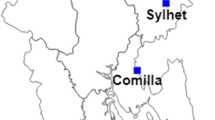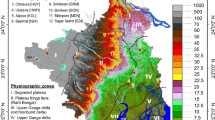Summary
Mean monthly rainfall data of 28 meteorological stations in Nigeria for the period 1911–1980 are analysed to examine trends in precipitation patterns in the country. Specifically, four 40-year periods (1911–50, 1921–60, 1931–70 and 1941–80) have been studied in detail.
Results show three prominent features. First, both the amount and area of the secondary rainfall maximum at 9°–10°N latitude in Nigeria has depreciated with time. Second, the belt of relative minimum rainfall, with its east-west axis almost coincident with the channels of the rivers Niger and Benue, appears to be expanding with time. Last, while places north of 8°N latitude (the mean axis of the belt of relative minimum rainfall) receive 90–100% of the annual total rainfall from April to October, fluctuations of the wet or rainy season contribution to total annual rainfall further south is about 84–88%.
These aberrations, which imply a decrease in the dry season contribution to the annual rainfall, suggest a drier environment in the long-term, especially if drought spells of the type 1969–73 and 1979–84 become a regular feature in West Africa. The planning implications are discussed in relation to water-use problems.
Zusammenfassung
Mittlere Monatssummen des Niederschlags von 28 meteorologischen Stationen in Nigeria von 1911–1980 wurden analysiert, um Trends in den Niederschlagsverteilungen des Landes zu untersuchen. Insbesondere wurden die 40-Jahresperioden 1911–50, 1921–60, 1931–70 und 1941–80 bearbeitet.
Die Ergebnisse zeigen drei bedeutende Merkmale. Erstens, Menge und Niederschlagsgebiet des sekundären Maximums in 9–10° nördlicher Breite wurden kleiner. Zweitens, der Gürtel eines relativen Niederschlagsminimums, dessen Ost-West-Achse fast mit den Flußläufen von Niger und Benue zusammenfällt, scheint sich auszudehnen. Und schließlich, während Orte nördlich von 8° nördl. Breite (der Hauptachse des Niederschlagsminimums) 90–100% der Jahressumme von April bis Oktober empfangen, beträgt die Schwankung des Anteils von Regen- und Trockenzeit weiter im Süden 84–88%. Diese Abweichungen, die eine Abnahme des Anteils der Trockenzeit zum Gesamtniederschlag bedeuten, lassen in Zukunft eine trockene Umwelt erwarten, besonders wenn die Trockenperioden von 1969–73 und 1979–84 sich wiederholen sollten. Es werden die Folgen für die Planung des Wasserverbrauches diskutiert.
Similar content being viewed by others
References
Adefolalu DO (1972) On the mean troposphere and lower tropospheric features over West Africa. M Sc thesis, FSU, Tall, USA, p 321
Adefolalu DO (1982) On Nigeria's green revolution programme and land-use planning — a bioclimatic perspective — Proc Nig Geog Assoc, p 22
Adefolalu DO (1983a) Desertification of the Sahel. In: Natural resources in tropical countries, Sing Univ Press, pp 402–438
Adefolalu DO (1983b) Rainfall patterns in the coastal areas of Nigeria. Nig Geog J: 26, in press
Adefolalu DO (1985) On characteristics of precipitation and potential evapotranspiration in relation to climatic zones in Nig Geog J, under review
Adefolalu DO, Oguntoyinbo JS (1985) Some unique characteristics of mean rainfall over Nigeria. J Trop Geog 11
Ayoade JO (1976) Evaporation and evapotranspiration in Nigeria. J Trop Geog 43: 9–19
Faniran A (1982) River basin and food production: A perspective on the Nigerian experience. NGA Conf Univ of Ibadan, p 22
Flohn H, Henning D, Korff HC (1974) Possibilities and limitations of a large-scale water budget modification in the Sudan-Sahel Belt of Africa. Met Rdsch 27: 97–100
Gibbs WJ (1975) Drought, Spec Environ no 5, WMO no 403, pp 1–41
Kidson JW (1977) African rainfall and its relation to the upper circulation. Quart J R Met Soc 103: 441–456
Krishnamurti TN, Kanamitsu (1980) Planetary scale monsoons during drought and normal rainfall months. Proc Monsoon Dynamics, Cambridge Univ Press
Lamb HH (1979) Climate, present, past and future. Methuen, London, p 835
Landsberg HE (1975) Brought, a recurrent element of climate. WMO Rep no 403, pp 28–90
Leary CA (1984) Precipitation structure of the cloud clusters in a tropical easterly wave. Mon Wea Rev 112: 313–325
May LH, Milthorpe FL (1962) Drought resistances in plants. Commonwealth Bureau, “Plans and Field Crops”, pp 171–179
Nicholson SE (1981) Revised rainfall series for the West African subtropics. Mon Wea Rev 107: 620–623
Nicholson SE (1983) Sub-Saharan rainfall in the years 1976–80: Evidence of continued drought. Mon Wea Rev 111: 1646–1654
Oguntoyinbo JS (1965) Agro-climatic problems and cane-sugar industry in Nigeria. Nig Geog J 8: 83–97
Oguntoyinbo JS (1978) Climate. In: A geography of Nigerian development. Heinemann, pp 14–39
Sircoulon J (1984) La dimunition des resources en eau de surface en Sahel depuis 1968. WMO-FGGE Conf Dakar-Senegal, p 9
Todorov AV (1985) Sahel: The changing rainfall regime and the “normals” used for its assessment. J Clim Appl Met 24(2): 97–107
Walker J, Rowntree PR (1977) The effect of soil moisture on circulation and rainfall in a tropical model. Quart J R Met Soc 103: 29–46
Author information
Authors and Affiliations
Additional information
With 8 Figures
Rights and permissions
About this article
Cite this article
Adefolalu, D.O. Rainfall trends in Nigeria. Theor Appl Climatol 37, 205–219 (1986). https://doi.org/10.1007/BF00867578
Received:
Revised:
Issue Date:
DOI: https://doi.org/10.1007/BF00867578




